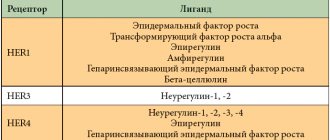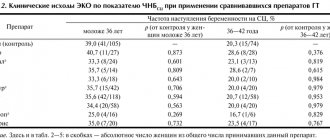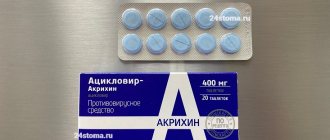Pharmacological properties of the drug Gemcitabine
An antitumor agent of the antimetabolite group, a structural analogue of pyrimidine. Metabolized intracellularly with the participation of nucleoside kinase to active diphosphate (dFdCDP) and triphosphate (dFdCTP) nucleosides. The cytotoxic effect of gemcitabine is due to inhibition of DNA synthesis by its active metabolites. After the inclusion of the drug in DNA, 1 additional nucleoside is added to the DNA strand being synthesized, after which its synthesis is completely inhibited and cell death occurs. After a single administration of gemcitabine at a dose of 1000 mg per 1 m2 of body surface, 92–98% of the dose is eliminated within 1 week. 99% of gemcitabine and its inactive uracil metabolite 2′-deoxy-2′,2′-difluorouridine (dFdU) are excreted in the urine, and less than 1% in feces. Gemcitabine practically does not bind to plasma proteins, and therefore its distribution in tissues is insignificant. Gemcitabine is rapidly metabolized by cytidine deaminose to dFdU in the liver, kidney, blood and other tissues. Less than 10% of gemcitabine is excreted unchanged in the urine. The dFdU metabolite actively penetrates tissues and is excreted in the urine without further biotransformation. Metabolite excretion may be reduced if renal function is impaired. In isolated liver dysfunction, only the rate of dFdU formation may slow down, but not the rate of its elimination. The pharmacokinetics of gemcitabine is linear and depends on the gender of the patient. Clearance in women is 60–80% of that in men and is proportional to body surface area. The maximum concentration in blood plasma is 10–40 mcg/ml and is achieved at the end of its intravenous administration for 30 minutes (single dose 1000 mg per 1 m2 of body surface). The plasma concentration of gemcitabine is characterized by a biphasic curve with a terminal half-life of 17 minutes. With a single infusion in doses of 1000–2500 mg per 1 m2 of body surface over 1 hour or less, the half-life ranges from 11 to 26 minutes, with longer administration (3.6–4.3 hours) in doses of 2500 and 3600 mg per 1 m2 of body surface - within 18–57 minutes. With repeated administrations, the half-life of gemcitabine is longer than with single doses, regardless of the duration of infusion. The distribution of gemcitabine depends on the cyclicity of administration and the number of cycles. The active metabolite dFdCTP is detected in blood mononuclear cells. The half-life of dFdCTP from mononuclear cells is 0.7–12 hours. The initial concentration of gemcitabine in blood plasma when administered 1000 mg per 1 m2 of body surface over 30 minutes exceeds 5 μg/ml within 30 minutes after the end of the infusion and 0.4 μg/ml - within 1 hour.
Use of the drug Gemcitabine
Only intravenously, adults are usually prescribed a dose of 1000 mg per 1 m2 of body surface intravenously for 30 minutes once a week for 3 weeks; after a week's break, the treatment cycle is repeated. In patients receiving gemcitabine, peripheral blood composition is examined every week; when the number of leukocytes is more than 1000 per 1 mm3 and platelets - 100,000 per 1 mm3, there is no need for dose adjustment. When the number of leukocytes decreases to 500-1000 per 1 mm3 and platelets - to 50,000-100,000 per 1 mm3, the dose is reduced to 70% of the recommended; if the number of leukocytes is less than 500 per 1 mm3, and platelets are less than 50,000 per 1 mm3, gemcitabine is canceled. Gemcitabine can only be diluted with 0.9% sodium chloride injection solution, which does not contain preservatives, to a maximum solution concentration of 40 mg/ml. Preparing the solution in higher concentrations should be avoided, since gemcitabine may not dissolve completely.
Gemcitabine-Actavis, 1000 mg, lyophilisate for solution for infusion, 1 pc.
Gemcitabine-Actavis is administered intravenously over 30 minutes.
For non-small cell lung cancer (locally advanced or metastatic) as monotherapy, the recommended dose of the drug is 1000 mg/m2 on days 1, 8 and 15 of each 28-day cycle.
When used as part of combination therapy with cisplatin, the recommended dose of the drug is 1250 mg/m2 on days 1 and 8 of each 21-day cycle or 1000 mg/m2 on days 1, 8 and 15 of each 28-day cycle. Cisplatin is administered at a dose of 70-100 mg/m2 on day 1 of the cycle after gemcitabine infusion against the background of hyperhydration.
When used as part of combination therapy with carboplatin, the recommended dose of the drug is 1000 mg/m2 or 1200 mg/m2 on days 1 and 8 of each 21-day cycle. Carboplatin is administered at a dose of AUC 5.0 mg/ml*min on the 1st day of the cycle after gemcitabine infusion.
For breast cancer (locally advanced or metastatic) as monotherapy with disease progression after first-line therapy, including anthracyclines in the absence of contraindications to them, the recommended dose of the drug is 1000-1200 mg/m2 on days 1, 8 and 15 of each 28-day cycle .
When used as part of combination therapy as first-line therapy for disease progression after neoadjuvant and/or adjuvant therapy, including anthracyclines, the recommended dose of the drug is 1250 mg/m2 on days 1 and 8 in combination with paclitaxel, which is administered after gemcitabine at a dose of 175 mg/m2 on day 1 of each 21-day cycle by intravenous drip over approximately 3 hours.
For urothelial cancer (locally advanced, metastatic and superficial) as monotherapy, the recommended dose of the drug is 1250 mg/m2 on days 1, 8 and 15 of each 28-day cycle.
When used as part of combination therapy, the recommended dose of the drug is 1000 mg/m2 on days 1, 8 and 15 in combination with cisplatin, which is administered at a dose of 70 mg/m2, immediately after gemcitabine infusion on days 1 or 2 of each 28-day cycle .
For epithelial ovarian cancer (locally advanced or metastatic) as monotherapy, the recommended dose of the drug is 800-1250 mg/m2, on days 1, 8 and 15 of each 28-day cycle.
When used as part of combination therapy, the recommended dose of the drug is 1000 mg/m2 on days 1 and 8 in combination with carboplatin at a dose of AUC 4.0 mg/ml*min, which is administered immediately after gemcitabine infusion on day 1 of each 21-day cycle.
For pancreatic cancer (locally advanced or metastatic) as monotherapy, the recommended dose of the drug is 1000 mg/m2 once a week for 7 weeks, followed by a one-week break. The drug is then administered on days 1, 8 and 15 of each 28-day cycle.
For cervical cancer (locally advanced or metastatic), combination therapy is performed. For locally advanced cancer with sequential chemotherapy and radiation therapy (neoadjuvant) and for metastatic cancer, gemcitabine is administered at a dose of 1250 mg/m2 on days 1 and 8 of each 21-day cycle. Cisplatin is administered after the administration of gemcitabine at a dose of 70 mg/m2 on day 1 of the cycle against the background of hyperhydration.
For locally advanced cancer with simultaneous chemotherapy and radiation therapy, gemcitabine is administered once a week 1-2 hours before the start of radiation therapy at a dose of 125 mg/m2, followed (immediately after the administration of gemcitabine) by cisplatin at a dose of 40 mg/m2.
Dose adjustment of the drug due to hematological toxicity
Beginning of the treatment cycle
Regardless of the indication, before each administration of gemcitabine, it is necessary to monitor the number of platelets, leukocytes and granulocytes in the blood. If there are signs of suppression of bone marrow function, it is necessary to suspend treatment or adjust the dose.
The condition for starting treatment is an absolute neutrophil count of at least 1500/μl and a platelet count of at least 100,000/μl.
If hematological toxicity occurs, the dose of gemcitabine can be reduced or the administration of the drug should be delayed according to the following regimen.
Dose modification of gemcitabine used alone or in combination with cisplatin in the treatment of urothelial cancer, non-small cell lung cancer and pancreatic cancer.
| Absolute number of neutrophils (in 1 µl) | Platelet count (in 1 µl) | % of previous dose | |
| >1000 | And | >100 000 | 100 |
| 500-1000 | or | 50000-100000 | 75 |
| <500 | or | <50000 | Postpone administration* |
*If the neutrophil count increases to 500/μl and platelet count to 50,000/μl, gemcitabine administration can be continued within the cycle.
Dose modification of gemcitabine used in combination with paclitaxel in the treatment of breast cancer.
| Absolute number of neutrophils (in 1 µl) | Platelet count (in 1 µl) | % of previous dose | |
| >1200 | And | >75000 | 100 |
| 1000-<1200 | or | 50000-75000 | 75 |
| 700-<1000 | And | ≥50000 | 50 |
| <700 | or | <50000 | Postpone administration* |
*Treatment within a cycle is not renewed. The next administration of gemcitabine is carried out on the 1st day of the next cycle when the number of neutrophils is restored to at least 1500/μl and platelets to 100,000/μl.
Dose modification of gemcitabine used in combination with carboplatin in the treatment of ovarian cancer.
| Absolute number of neutrophils (in 1 µl) | Platelet count (in 1 µl) | % of previous dose | |
| >1500 | And | ≥100000 | 100 |
| 1000-1500 | or | 75000-100000 | 50 |
| <1000 | or | <75000 | Postpone administration* |
*Treatment within a cycle is not renewed. The next administration of gemcitabine is carried out on the 1st day of the next cycle when the number of neutrophils is restored to at least 1500/μl and platelets to 100,000/μl.
The dose of gemcitabine in the next cycle should be reduced by 25% for all indications in cases where the following was observed during the previous cycle:
- decrease in the absolute number of neutrophils <500/μl, lasting more than 5 days,
- decrease in the absolute number of neutrophils <100/μl, lasting more than 3 days,
- febrile neutropenia,
- decrease in platelet count <25,000/µl,
- cycle was delayed more than 1 week due to hematologic toxicity.
Drug dose adjustment due to non-hematological toxicity events
Periodic physical examination and monitoring of liver and kidney function should be performed to detect non-hematological toxicity. The dose of the drug can be reduced in each subsequent cycle or during a cycle already started, depending on the degree of toxicity of the drugs prescribed to the patient. In case of severe (grade 3 or 4) non-hematological toxicity, except in cases of nausea/vomiting, gemcitabine therapy should be suspended or the dose reduced depending on the judgment of the treating physician. The decision to restart treatment is made by the doctor.
There are no data demonstrating that dose adjustment is necessary in elderly patients, although gemcitabine clearance and T1/2 change with age.
Gemcitabine should be used with caution in patients with liver failure or impaired renal function, because There is no sufficient data on the use of the drug in this category of patients.
Mild or moderate renal impairment (glomerular filtration rate from 30 ml/min to 80 ml/min) does not have a significant effect on the pharmacokinetics of gemcitabine.
Gemcitabine has not been studied in children.
Rules for preparing solution for infusion
Only 0.9% sodium chloride solution is used as a solvent (without preservatives).
Cmax of gemcitabine should not exceed 40 mg/ml. In solutions prepared with a concentration of more than 40 mg/ml, incomplete dissolution of the lyophilisate is possible.
1. To prepare the solution, you must adhere to the requirements for preparing solutions for intravenous administration.
2. To prepare a solution for infusion, the contents of a bottle of 200 mg are dissolved in 5 ml, and 1 g in 25 ml of 0.9% sodium chloride solution for injection (without preservatives). The total volume after dilution is 5.26 ml (for 200 mg) and 26.3 ml (for 1000 mg), respectively. At this dilution, the concentration of gemcitabine is 38 mg/ml, taking into account the volume of the lyophilisate. Shake the bottle until the lyophilisate is completely dissolved. The prepared gemcitabine solution containing the required dose of the drug is diluted before administration with 0.9% sodium chloride solution for injection (without preservatives) in an amount sufficient for a 30-minute IV infusion. The resulting solution should be transparent, colorless to pale yellow.
3. Before parenteral administration, it is necessary to visually monitor the prepared solution for the presence of mechanical impurities and color changes. Do not administer the solution if particles are found in it.
Side effects of the drug Gemcitabine
Anemia, leukopenia, granulocytopenia, thrombocytopenia, hemorrhages due to thrombocytopenia, transient increase in transaminase activity, alkaline phosphatase and increase in the concentration of bilirubin in the blood plasma, nausea, vomiting, diarrhea, constipation, nephrotoxic effect (proteinuria, hematuria, cases of renal failure have been described), hemolytic uremic syndrome, shortness of breath, skin rash, itching, skin peeling, bullous rash, alopecia, stomatitis, injection site reactions, transient bronchospasm, anaphylactoid reactions, neurotoxicity (drowsiness, asthenia, paresthesia), influenza-like syndrome (fever, headache, pain in back, chills, myalgia, asthenia, anorexia, cough, rhinitis, malaise, excessive sweating and insomnia), peripheral edema, pulmonary edema, arterial hypotension, cases of myocardial infarction, congestive heart failure and arrhythmias have been described (a direct relationship with gemcitabine has not been established ).
Adverse reactions
The fundamentally low toxicity of gemcitabine allows it to be combined with a variety of drugs. The most common complication is a flu-like syndrome in the form of fever, joint aches, muscle soreness, weakness and sweating. Almost half of the patients experience varying degrees of severity and a varied combination of symptoms. Some patients complain only of prolonged malaise with severe weakness.
Nausea and vomiting are very mild and often absent, and changes in the blood picture with a decrease in the number of leukocytes are uncommon in clinical practice when gemcitabine is used as the only drug; in combination with other drugs, the decrease in the level of leukocytes can be significant.
When treated with the drug, vaccinations cannot be carried out for almost a whole year, since a reverse reaction in the form of an infectious infection is possible. Use with caution for kidney and liver diseases. But in general, the toxicity of the drug can be considered moderate compared to most chemotherapy drugs.
The drug increases radiation damage to tissues, which is called radiosensitization; this property is used for its intended purpose and, at the same time, can adversely affect the complications of radiation therapy.
To select the optimal drug for chemotherapy, taking into account individual characteristics and possible adverse reactions, or to conduct a course of chemotherapy with gemcitabine, call +7 (495) 023-10-24.
Special instructions for the use of the drug Gemcitabine
During treatment, careful clinical monitoring should be ensured, appropriate laboratory tests and treatment of intoxication in patients should be carried out. Gemcitabine should be prescribed with caution to patients with impaired liver or kidney function, bone marrow function, and also take into account the possibility of a cumulative effect on it during combined or sequential administration of chemotherapy. It is necessary to determine the number of platelets, leukocytes and granulocytes in the peripheral blood weekly and, if signs of myelotoxicity appear, suspend or change treatment. The decrease in the number of blood cells may continue even after discontinuation of therapy. Gemcitabine has embryotoxic effects, so women of childbearing age should use effective contraception. Breastfeeding should be discontinued during treatment with gemcitabine. The safety and effectiveness of gemcitabine in children have not been established. Gemcitabine can cause drowsiness, so patients should refrain from driving or operating potentially dangerous machinery until somnolence disappears.
Gemcitabine: indications
The drug gemcitabine is now indispensable for the treatment of all forms of pancreatic cancer; it is administered in all standard combinations to most patients, both for intractable tumors and for metastases, and for the prevention of relapse after radical surgery. Before its appearance in clinical practice, the situation of patients with advanced breast cancer was hopelessly bad.
Before chemotherapy, the tumor is examined for the hENT1 protein, as it facilitates the delivery of the drug into the cell; if the amount of protein is minute, then the tumor will not respond to treatment with gemcitabine. The optimal duration of treatment has not yet been determined; courses are carried out until the disease progresses.
The drug is actively used for lung cancer - small cell and non-small cell. It is included in combinations for breast cancer, but is not a priority, since its activity is somewhat inferior to other anticancer drugs. For treatment-resistant advanced testicular cancer and bladder cancer, for cervical and ovarian cancer, it is actively used in various combinations with a variety of cytostatics.



